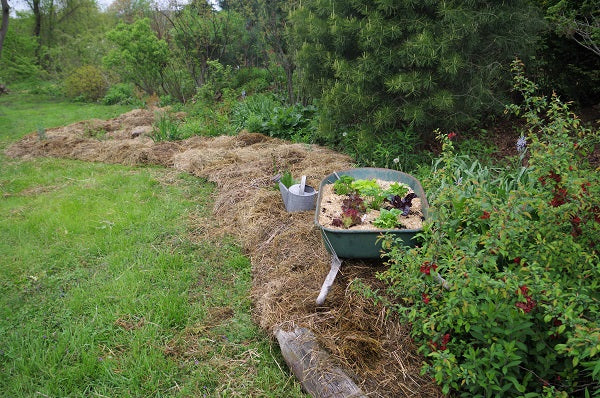
Passive Bed Preparation
Nancy DuBruleShare
Are you looking for an easy way to prepare your beds for future planting projects? If you know where the beds are going to go, but have a little time to wait, you can do passive bed preparation. It really is as wonderful as it sounds!

- Lay out your bed lines on the ground. If you are dealing with a lawn area, mow it as low as possible. If you are dealing with weeds or vegetation, cut it to the ground. Haul away the big debris.
- If you want to amend the bed ahead of time, you can add compost, lime, organic fertilizers and mineral powders next. The best way to determine what your soil needs is to take a soil test first. If you don't do this step at this point, you can always amend later, when it is time to plant.
- Now comes the fun part. Cover the entire bed with a smothering material that will decompose over time. Popular choices include flattened cardboard boxes, multiple sheets of newspaper, or Weed Barrier paper. Do not use landscape fabric or plastic. The goal is to smother the vegetation below and then have the smothering material break down and become part of the compost layer.

- Cover the smothering material with at least 2-3” of mulch. We often use shredded bark, but you can also use whole leaves, shredded leaves, grass clippings, or hay. As long as it is an organic material that will eventually decompose, it will work. The goal of this layer is to hold down the smothering material and to make the bed look finished. The coarser the material, the longer it will last.
- If you use leaves, wet them down thoroughly when you are done. This will keep them from blowing away and accelerated the decomposition process.

- The longer you leave this bed alone, and the warmer the temperature is during that time, the further along the passive bed preparation process will be. The soil microorganisms as well as the earthworms and other soil life digest and break down all of the materials within the layers. Eventually, you will have a beautiful, amended soil that will be easy to dig into to plant your perennials, shrubs, and trees.

Some Variations on the Process
- If you want to install some plant material before you smother, simply desod large circles where those plants will go. Hand dig and amend the planting holes. Smother and mulch the rest of the bed.
- You can install a landscape design in stages. As you layout your plants, dig under the mulch layer. If the smothering material is not broken down yet, cut a circle with a sharp knife, dig out any undecomposed vegetation, hand dig and amend the planting holes, then re-mulch.
- If you don’t get around to planting and the passive bed preparation process is done, you may eventually find weeds growing back. Simply lay down some more of the smothering material of your choice and add more mulch. This will hold the bed in a beautiful state of readiness indefinitely.

